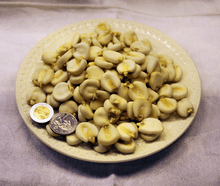Pozole
| Pozole | |
|---|---|
 | |
| Type | Soup |
| Place of origin | Mexico |
| Main ingredients | Hominy, meat (usually pork), chili peppers, seasonings |
|
| |
Pozole (Nahuatl: pozolli ![]() po'solːi ), which means "hominy"; variant spellings: pozolé, pozolli, or more commonly in the U.S. – posole)[1][2] is a traditional pre-Columbian soup or stew from Mexico, which once had ritual significance. Pozole was mentioned in Fray Bernardino de Sahagún's "General History of the Things of New
Spain" circa 1500. It is made from nixtamalized cacahuazintle maize,[1] with meat, usually pork, chicken, turkey, pork rinds, chili peppers, and other seasonings and garnish such as cabbage, salsa and limes and/or lemons.[3] After colonization by the Spaniards, the ingredients of pozole changed, but the staple maize remained. It is a typical dish in various states such as Sinaloa, Michoacán, Guerrero, Zacatecas, Jalisco, Morelos, State of Mexico and Distrito Federal. Pozole is served in Mexican restaurants worldwide.
po'solːi ), which means "hominy"; variant spellings: pozolé, pozolli, or more commonly in the U.S. – posole)[1][2] is a traditional pre-Columbian soup or stew from Mexico, which once had ritual significance. Pozole was mentioned in Fray Bernardino de Sahagún's "General History of the Things of New
Spain" circa 1500. It is made from nixtamalized cacahuazintle maize,[1] with meat, usually pork, chicken, turkey, pork rinds, chili peppers, and other seasonings and garnish such as cabbage, salsa and limes and/or lemons.[3] After colonization by the Spaniards, the ingredients of pozole changed, but the staple maize remained. It is a typical dish in various states such as Sinaloa, Michoacán, Guerrero, Zacatecas, Jalisco, Morelos, State of Mexico and Distrito Federal. Pozole is served in Mexican restaurants worldwide.
Ritual significance

Since maize was a sacred plant for the Aztecs and other inhabitants of Mesoamerica, pozole was made to be consumed on special occasions. The conjunction of maize (usually whole hominy kernels) and meat in a single dish is of particular interest to scholars because the ancient Americans believed the gods made humans out of masa (cornmeal dough). According to research by the National Institute of Anthropology and History and the Universidad Nacional Autónoma de México, on these special occasions, the meat used in the pozole was human.[5] After the prisoners were killed by having their hearts torn out in a ritual sacrifice, the rest of the body was chopped and cooked with maize. The meal was shared among the whole community as an act of religious communion. After the Conquest, when cannibalism was banned, pork became the staple meat as it "tasted very similar", according to a Spanish priest.[5]
Pozole is frequently served as a celebratory dish throughout both New Mexico and Mexico, including quinceañeras, weddings, birthdays and New Year's celebrations.
- Pozole
-
Green pozole cooked in Guerrero State fashion
-

Dried hominy, which is often soaked and used for pozole
See also
- food portal
References
- ↑ 1.0 1.1 Clark, Melissa (2010-02-17). "Save the Pig’s Head for Later". New York Times. Retrieved 2010-05-13.
- ↑ Campbell, Cathie. "Stir Crazy: It's not too late for nice, hot soup". Madera Tribune. Retrieved 2010-05-15.
- ↑ Duggan, Tara (2009-12-27). "Pozole: Streamlined and budget friendly". San Francisco Chronicle. Retrieved 2010-05-15.
- ↑ Pozolli. (n.d.). Nahuatl dictionary. Retrieved August 28, 2012, from http://whp.uoregon.edu/dictionaries/nahuatl/index.lasso
- ↑ 5.0 5.1 "Los mexicanos prehispánicos comían pozole con carne humana – La Crónica de Hoy / Lunes 13 de Dic., 2010". Cronica.com.mx. Retrieved 2010-12-13.
Bibliography
- de Sahagún, Bernardino (2008). Historia de las Cosas de la Nueva España. Barcelona: Linkgua. ISBN 84-9816-849-X..
External links
| ||||||||||
